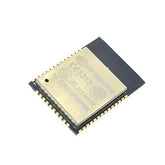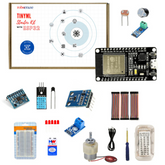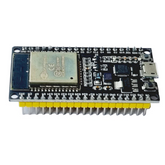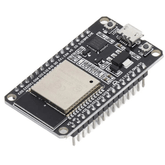What is Esp32 Development Board
Summary
Dive into the realm of ESP32 Development Boards with our enlightening blog! We kick off with an Introduction, setting the stage for an exploration into this versatile device. Understanding ESP32 Specifications empowers you to harness its full potential, while a head-to-head Comparison with ESP8266 sheds light on its superiority. Discover a variety of ESP32 Development Boards available, each with its unique features. Learn the ropes of Programming the ESP32, unlocking endless possibilities. Join us on this journey of innovation and exploration! Read now for an electrifying conclusion.
Introduction
The ESP32, a microcontroller developed by Espressif, represents a significant leap in the realm of embedded systems. Serving as the successor to the ESP8266, it boasts a myriad of enhanced features, making it a cornerstone in the Internet of Things (IoT) ecosystem.
The ESP32 integrates Wi-Fi and Bluetooth functionalities, making it adept at wireless communication. Its dual-core processor ensures robust performance, while its versatile input/output interface facilitates seamless interaction with external devices.
When considering microcontrollers for your projects, several compelling reasons make the ESP32 a standout choice.

With ESP32 boards available for as little as $6, the barrier to entry is remarkably low, democratizing access to advanced IoT capabilities.
The ESP32's ability to operate in deep sleep mode conserves power, making it ideal for battery-powered applications where energy efficiency is paramount.
Equipped with both Wi-Fi and Bluetooth functionalities, the ESP32 seamlessly connects to networks and peripherals, opening avenues for a wide range of applications.
Featuring dual-core architecture, the ESP32 offers enhanced processing power, enabling it to handle complex tasks with ease.
The ESP32's rich peripheral interface supports various input and output functionalities, including analog-to-digital conversion, serial communication, and pulse-width modulation.
For developers familiar with Arduino or MicroPython, the ESP32 offers a familiar programming environment, easing the transition to this powerful platform.
Understanding ESP32 Specifications
Delving deeper into the ESP32's specifications reveals a robust architecture designed to meet the demands of modern IoT applications.
The ESP-WROOM-32 module serves as the foundation of the ESP32, providing seamless integration of wireless connectivity and processing capabilities.
The ESP32 supports high-speed Wi-Fi and Bluetooth connectivity, with data rates of up to 150 Mbps, ensuring swift and reliable communication.

Powered by the Tensilica Xtensa Dual-Core 32-bit LX6 microprocessor, the ESP32 delivers exceptional performance for computation-intensive tasks.
With a combination of ROM, SRAM, and eFuse memory, the ESP32 offers ample storage for program code, data, and system configuration.
The ESP32's versatile input/output interface plays a pivotal role in interfacing with external devices and sensors.
From analog-to-digital converters to serial communication interfaces, the ESP32's peripheral interface caters to a wide range of project requirements.
These interfaces serve as the bridge between the ESP32 and external components, enabling seamless data exchange and control.
Comparison: ESP32 vs ESP8266
A comparative analysis between the ESP32 and its predecessor, the ESP8266, highlights significant advancements in terms of performance and functionality.
The ESP32's dual-core architecture affords multitasking capabilities, enhancing overall system responsiveness.
With faster data rates and improved signal strength, the ESP32 outperforms the ESP8266 in wireless communication.
The ESP32 boasts a higher GPIO count, providing greater flexibility in project design and implementation.

Unlike the ESP8266, the ESP32 features built-in Bluetooth support, enabling seamless integration with Bluetooth-enabled devices.
The presence of dual CPU cores in the ESP32 enables parallel processing, resulting in improved performance and efficiency.
While the ESP32 commands a slightly higher price tag compared to the ESP8266, its advanced features and enhanced capabilities justify the investment.
Despite the marginal price difference, the ESP32's superior performance and versatility make it a cost-effective choice for IoT projects.
The ESP32's comprehensive feature set and compatibility with popular programming languages offer unparalleled value to developers and hobbyists alike.
Overview of ESP32 Development Boards
Development boards play a crucial role in the prototyping and development phase of IoT projects, offering a convenient platform for experimentation and testing.
Development boards serve as a bridge between the ESP32 microcontroller and the external world, providing essential connectivity and hardware interfaces.
With plug-and-play functionality and comprehensive documentation, development boards simplify the process of getting started with ESP32 development.
Choosing the right development board is essential for ensuring compatibility and functionality in your projects.
Development boards equipped with USB-to-UART interfaces and voltage regulators facilitate seamless communication and power management.
The presence of BOOT and RESET/EN buttons simplifies the flashing and reset procedures, streamlining the development workflow.
Adequate pin configuration and GPIO count are crucial for accommodating project requirements and interfacing with external peripherals.
Development boards with integrated antennas and battery connectors offer enhanced flexibility and mobility in IoT applications.
Among the myriad of ESP32 development boards available, certain models stand out for their performance and features.
The ESP32 DEVKIT DOIT board, renowned for its reliability and versatility, serves as an ideal platform for beginners and experienced developers alike.
While the ESP32 DEVKIT DOIT offers excellent value for money, alternative boards such as the Adafruit ESP32 Feather and Sparkfun ESP32 Thing cater to specific project requirements.
With a dual-core processor, ample GPIO count, and built-in USB-to-UART interface, the ESP32 DEVKIT DOIT board provides the perfect blend of performance and convenience.
Programming the ESP32
The ESP32 supports a diverse range of programming options, catering to developers with varying preferences and expertise levels.
From Arduino C/C++ to MicroPython and JavaScript, the ESP32 offers a multitude of options for writing and deploying code.
Arduino IDE serves as a beginner-friendly platform for programming the ESP32, offering a familiar environment for Arduino enthusiasts.

Installing and configuring Arduino IDE for ESP32 development is a straightforward process, requiring minimal setup.
With a vast repository of examples and libraries, Arduino IDE simplifies the code development process, allowing users to upload code to the ESP32 with ease.
Conclusion
The ESP32 development board represents a game-changer in the field of embedded systems, offering unparalleled performance, versatility, and ease of use.
From its dual-core processor to its extensive peripheral interface, the ESP32 excels in meeting the diverse needs of IoT projects.
As the backbone of countless IoT applications, the ESP32 plays a pivotal role in shaping the future of connected devices and smart technologies.
For those embarking on their journey with ESP32 development, the road ahead is filled with endless possibilities.
Exploring advanced features, experimenting with different programming languages, and engaging with the vibrant ESP32 community are just a few avenues for further exploration.
Frequently Asked Questions
1. What are the primary applications of ESP32 in IoT?
The primary applications of ESP32 in IoT include:
2. How can I troubleshoot common issues while programming ESP32?
To troubleshoot common issues while programming ESP32, you can follow these steps:
3. What is ESP32 used for?
ESP32 is a versatile microcontroller widely used for IoT projects, home automation, and wearable devices. It enables applications that require both Wi-Fi and Bluetooth connectivity, making it ideal for smart sensors, data logging systems, and real-time monitoring. The flexibility and performance of ESP32 allow developers to create robust solutions across various fields like robotics and environmental monitoring.
4. How is ESP32 different from ESP8266?
ESP32 offers enhanced features compared to ESP8266, including dual-core processing, Bluetooth support, and more GPIO pins. While ESP8266 is limited to Wi-Fi connectivity, ESP32 supports both Wi-Fi and Bluetooth Classic/LE, making it more versatile for complex IoT applications. The processing power and memory in ESP32 are also significantly higher, enabling more demanding applications.
5. What are the main features of ESP32?
Key features of ESP32 include dual-core processing, integrated Wi-Fi and Bluetooth, rich GPIO options, and ADCs for sensor integration. It's energy-efficient, supports various communication protocols, and has built-in support for advanced security measures. These features make ESP32 an excellent choice for a variety of applications, from IoT devices to edge computing solutions.
6. Does ESP32 support both Wi-Fi and Bluetooth?
Yes, ESP32 supports both Wi-Fi and Bluetooth, including Bluetooth Classic and BLE (Bluetooth Low Energy). This dual connectivity allows developers to create versatile applications that can communicate with various devices and sensors seamlessly. It's especially useful for projects requiring multiple types of communication protocols for enhanced functionality.
7. How to program ESP32 using Arduino IDE?
To program ESP32 using Arduino IDE, first, install the ESP32 board library via the Board Manager. Select the appropriate board under Tools, then write your sketch in the IDE. Connect the ESP32 to your computer, select the correct port, and click on 'Upload' to transfer the code to the device. Make sure to set the right board settings for optimal performance.
8. Can ESP32 run on battery power?
Yes, ESP32 can run on battery power, making it suitable for portable applications. With its low power consumption features, such as deep sleep mode, developers can extend battery life significantly. It's an excellent option for IoT projects where mobility and efficiency are crucial, allowing you to deploy sensors and devices without a constant power source.
9. What sensors can be connected to ESP32?
ESP32 can connect to a wide variety of sensors, including temperature and humidity sensors like DHT11, motion sensors like PIR, and environmental sensors such as MQ series gas sensors. Additionally, it supports analog sensors via its ADC pins. This versatility allows for the development of comprehensive IoT solutions across different fields and applications.
10. What is the GPIO pin count of ESP32?
ESP32 typically features 34 GPIO pins, with many capable of multiple functions such as PWM, ADC, and UART. This extensive GPIO pin count allows for significant flexibility in connecting various sensors and modules, making ESP32 suitable for complex projects requiring a higher number of connections and functionalities.
11. How to upload code to ESP32?
To upload code to ESP32, use the Arduino IDE. Connect the ESP32 to your computer via USB, select the correct board and port from the Tools menu, then click the 'Upload' button. Make sure your code has no compilation errors for successful uploads. Once uploaded, the ESP32 will automatically restart, running your code immediately.
12. Is ESP32 suitable for AI or ML projects?
Yes, ESP32 is suitable for AI and ML projects, especially those requiring edge computing. Its processing power and support for frameworks like TensorFlow Lite enable running lightweight models directly on the device. This capability allows for real-time data processing and decision-making, making it a compelling choice for smart applications in various fields.
1. What are the primary applications of ESP32 in IoT?
The primary applications of ESP32 in IoT include:
2. How can I troubleshoot common issues while programming ESP32?
To troubleshoot common issues while programming ESP32, you can follow these steps:
3. What is ESP32 used for?
ESP32 is a versatile microcontroller widely used for IoT projects, home automation, and wearable devices. It enables applications that require both Wi-Fi and Bluetooth connectivity, making it ideal for smart sensors, data logging systems, and real-time monitoring. The flexibility and performance of ESP32 allow developers to create robust solutions across various fields like robotics and environmental monitoring.
4. How is ESP32 different from ESP8266?
ESP32 offers enhanced features compared to ESP8266, including dual-core processing, Bluetooth support, and more GPIO pins. While ESP8266 is limited to Wi-Fi connectivity, ESP32 supports both Wi-Fi and Bluetooth Classic/LE, making it more versatile for complex IoT applications. The processing power and memory in ESP32 are also significantly higher, enabling more demanding applications.
5. What are the main features of ESP32?
Key features of ESP32 include dual-core processing, integrated Wi-Fi and Bluetooth, rich GPIO options, and ADCs for sensor integration. It's energy-efficient, supports various communication protocols, and has built-in support for advanced security measures. These features make ESP32 an excellent choice for a variety of applications, from IoT devices to edge computing solutions.
6. Does ESP32 support both Wi-Fi and Bluetooth?
Yes, ESP32 supports both Wi-Fi and Bluetooth, including Bluetooth Classic and BLE (Bluetooth Low Energy). This dual connectivity allows developers to create versatile applications that can communicate with various devices and sensors seamlessly. It's especially useful for projects requiring multiple types of communication protocols for enhanced functionality.
7. How to program ESP32 using Arduino IDE?
To program ESP32 using Arduino IDE, first, install the ESP32 board library via the Board Manager. Select the appropriate board under Tools, then write your sketch in the IDE. Connect the ESP32 to your computer, select the correct port, and click on 'Upload' to transfer the code to the device. Make sure to set the right board settings for optimal performance.
8. Can ESP32 run on battery power?
Yes, ESP32 can run on battery power, making it suitable for portable applications. With its low power consumption features, such as deep sleep mode, developers can extend battery life significantly. It's an excellent option for IoT projects where mobility and efficiency are crucial, allowing you to deploy sensors and devices without a constant power source.
9. What sensors can be connected to ESP32?
ESP32 can connect to a wide variety of sensors, including temperature and humidity sensors like DHT11, motion sensors like PIR, and environmental sensors such as MQ series gas sensors. Additionally, it supports analog sensors via its ADC pins. This versatility allows for the development of comprehensive IoT solutions across different fields and applications.
10. What is the GPIO pin count of ESP32?
ESP32 typically features 34 GPIO pins, with many capable of multiple functions such as PWM, ADC, and UART. This extensive GPIO pin count allows for significant flexibility in connecting various sensors and modules, making ESP32 suitable for complex projects requiring a higher number of connections and functionalities.
11. How to upload code to ESP32?
To upload code to ESP32, use the Arduino IDE. Connect the ESP32 to your computer via USB, select the correct board and port from the Tools menu, then click the 'Upload' button. Make sure your code has no compilation errors for successful uploads. Once uploaded, the ESP32 will automatically restart, running your code immediately.
12. Is ESP32 suitable for AI or ML projects?
Yes, ESP32 is suitable for AI and ML projects, especially those requiring edge computing. Its processing power and support for frameworks like TensorFlow Lite enable running lightweight models directly on the device. This capability allows for real-time data processing and decision-making, making it a compelling choice for smart applications in various fields.












